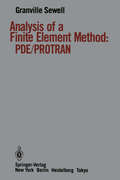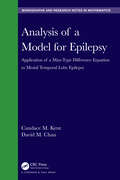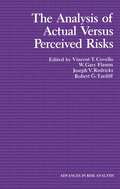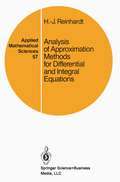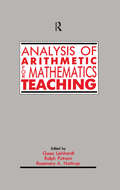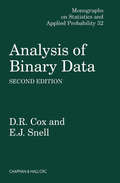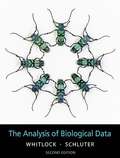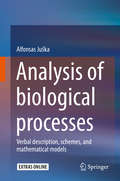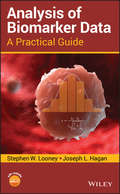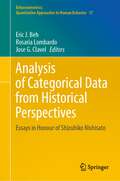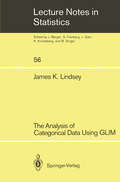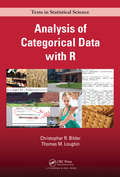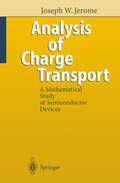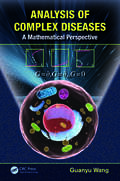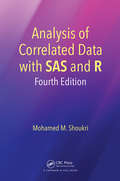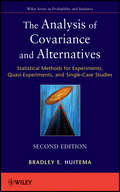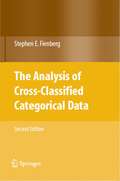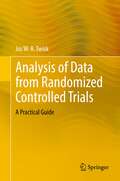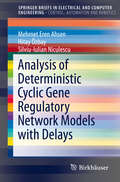- Table View
- List View
Analysis of a Finite Element Method: PDE/PROTRAN
by Granville SewellThis text can be used for two quite different purposes. It can be used as a reference book for the PDElPROTRAN user· who wishes to know more about the methods employed by PDE/PROTRAN Edition 1 (or its predecessor, TWODEPEP) in solving two-dimensional partial differential equations. However, because PDE/PROTRAN solves such a wide class of problems, an outline of the algorithms contained in PDElPROTRAN is also quite suitable as a text for an introductory graduate level finite element course. Algorithms which solve elliptic, parabolic, hyperbolic, and eigenvalue partial differential equation problems are pre sented, as are techniques appropriate for treatment of singularities, curved boundaries, nonsymmetric and nonlinear problems, and systems of PDEs. Direct and iterative linear equation solvers are studied. Although the text emphasizes those algorithms which are actually implemented in PDEI PROTRAN, and does not discuss in detail one- and three-dimensional problems, or collocation and least squares finite element methods, for example, many of the most commonly used techniques are studied in detail. Algorithms applicable to general problems are naturally emphasized, and not special purpose algorithms which may be more efficient for specialized problems, such as Laplace's equation. It can be argued, however, that the student will better understand the finite element method after seeing the details of one successful implementation than after seeing a broad overview of the many types of elements, linear equation solvers, and other options in existence.
Analysis of a Model for Epilepsy: Application of a Max-Type Difference Equation to Mesial Temporal Lobe Epilepsy (Chapman & Hall/CRC Monographs and Research Notes in Mathematics)
by Candace M. Kent David M. ChanIn the 1960s and 1970s, mathematical biologists Sir Robert M. May, E.C. Pielou, and others utilized difference equations as models of ecological and epidemiological phenomena. Since then, with or without applications, the mathematics of difference equations has evolved into a field unto itself. Difference equations with the maximum (or the minimum or the "rank-type") function were rigorously investigated from the mid-1990s into the 2000s, without any applications in mind. These equations often involved arguments varying from reciprocal terms with parameters in the numerators to other special functions. Recently, the authors of Analysis of a Model for Epilepsy: Application of a Max-Type Difference Equation to Mesial Temporal Lobe Epilepsy and their colleagues investigated the first known application of a "max-type" difference equation. Their equation is a phenomenological model of epileptic seizures. In this book, the authors expand on that research and present a more comprehensive development of mathematical, numerical, and biological results. Additionally, they describe the first documented instance of a novel dynamical behavior that they call rippled almost periodic behavior, which can be described as an unpredictable pseudo-periodic behavior. Features: Suitable for researchers in mathematical neuroscience and potentially as supplementary reading for postgraduate students Thoroughly researched and replete with references
Analysis of a Model for Epilepsy: Application of a Max-Type Difference Equation to Mesial Temporal Lobe Epilepsy (Chapman & Hall/CRC Monographs and Research Notes in Mathematics)
by Candace M. Kent David M. ChanIn the 1960s and 1970s, mathematical biologists Sir Robert M. May, E.C. Pielou, and others utilized difference equations as models of ecological and epidemiological phenomena. Since then, with or without applications, the mathematics of difference equations has evolved into a field unto itself. Difference equations with the maximum (or the minimum or the "rank-type") function were rigorously investigated from the mid-1990s into the 2000s, without any applications in mind. These equations often involved arguments varying from reciprocal terms with parameters in the numerators to other special functions. Recently, the authors of Analysis of a Model for Epilepsy: Application of a Max-Type Difference Equation to Mesial Temporal Lobe Epilepsy and their colleagues investigated the first known application of a "max-type" difference equation. Their equation is a phenomenological model of epileptic seizures. In this book, the authors expand on that research and present a more comprehensive development of mathematical, numerical, and biological results. Additionally, they describe the first documented instance of a novel dynamical behavior that they call rippled almost periodic behavior, which can be described as an unpredictable pseudo-periodic behavior. Features: Suitable for researchers in mathematical neuroscience and potentially as supplementary reading for postgraduate students Thoroughly researched and replete with references
The Analysis of Actual Versus Perceived Risks (Advances in Risk Analysis #1)
by V. T. Covello W. Gary Flamm Joseph V. Rodricks Robert G. TardiffIn 1980, a group of scientists from national laboratories, universities, and other research organizations gathered informally in a series of meetings to consider the state of research on risks to health, safety, and the environment. Each scientist had conducted research on the subject. All felt that the traditional disciplines and professional societies to which they belonged were neither ade quate nor appropriate for addressing the extraordinarily complex problems of assessing the risks inherent in modern society. The con sensus of the group was that a new society was needed to address these problems in a scientific and objective way. From these initial meetings, the Society for Risk Analysis was formed The major aims of the Society for Risk Analysis, as stated in its constitution, are • to promote knowledge and understanding of risk analysis techniques and their applications; • to promote communication and interaction among those engaged in risk analysis; and • to disseminate risk analysis information and promote the advancement of all aspects of risk analysis. Members of the Society are drawn from a variety of disciplines, including the health sciences, engineering, the physical sciences, the humanities, and the behavioral and social sciences. An import ant function of the Society is the annual meeting, at which var ious aspects of risk analysis are discussed. The first annual meet ing, represented by this volume, was the International Workshop on the Analysis of Actual vs.
Analysis of Approximation Methods for Differential and Integral Equations (Applied Mathematical Sciences #57)
by Hans-Jürgen ReinhardtThis book is primarily based on the research done by the Numerical Analysis Group at the Goethe-Universitat in Frankfurt/Main, and on material presented in several graduate courses by the author between 1977 and 1981. It is hoped that the text will be useful for graduate students and for scientists interested in studying a fundamental theoretical analysis of numerical methods along with its application to the most diverse classes of differential and integral equations. The text treats numerous methods for approximating solutions of three classes of problems: (elliptic) boundary-value problems, (hyperbolic and parabolic) initial value problems in partial differential equations, and integral equations of the second kind. The aim is to develop a unifying convergence theory, and thereby prove the convergence of, as well as provide error estimates for, the approximations generated by specific numerical methods. The schemes for numerically solving boundary-value problems are additionally divided into the two categories of finite difference methods and of projection methods for approximating their variational formulations.
Analysis of Arithmetic for Mathematics Teaching
by Gaea LeinhardtThis volume emerges from a partnership between the American Federation of Teachers and the Learning Research and Development Center at the University of Pittsburgh. The partnership brought together researchers and expert teachers for intensive dialogue sessions focusing on what each community knows about effective mathematical learning and instruction. The chapters deal with the research on, and conceptual analysis of, specific arithmetic topics (addition, subtraction, multiplication, division, decimals, and fractions) or with overarching themes that pervade the early curriculum and constitute the links with the more advanced topics of mathematics (intuition, number sense, and estimation). Serving as a link between the communities of cognitive researchers and mathematics educators, the book capitalizes on the recent research successes of cognitive science and reviews the literature of the math education community as well.
Analysis of Arithmetic for Mathematics Teaching
by Gaea Leinhardt Ralph Putnam Rosemary A. HattrupThis volume emerges from a partnership between the American Federation of Teachers and the Learning Research and Development Center at the University of Pittsburgh. The partnership brought together researchers and expert teachers for intensive dialogue sessions focusing on what each community knows about effective mathematical learning and instruction. The chapters deal with the research on, and conceptual analysis of, specific arithmetic topics (addition, subtraction, multiplication, division, decimals, and fractions) or with overarching themes that pervade the early curriculum and constitute the links with the more advanced topics of mathematics (intuition, number sense, and estimation). Serving as a link between the communities of cognitive researchers and mathematics educators, the book capitalizes on the recent research successes of cognitive science and reviews the literature of the math education community as well.
Analysis of Binary Data
by D.R. CoxThe first edition of this book (1970) set out a systematic basis for the analysis of binary data and in particular for the study of how the probability of 'success' depends on explanatory variables. The first edition has been widely used and the general level and style have been preserved in the second edition, which contains a substantial amount of new material. This amplifies matters dealt with only cryptically in the first edition and includes many more recent developments. In addition the whole material has been reorganized, in particular to put more emphasis on m.aximum likelihood methods.There are nearly 60 further results and exercises. The main points are illustrated by practical examples, many of them not in the first edition, and some general essential background material is set out in new Appendices.
Analysis of Binary Data
by D.R. CoxThe first edition of this book (1970) set out a systematic basis for the analysis of binary data and in particular for the study of how the probability of 'success' depends on explanatory variables. The first edition has been widely used and the general level and style have been preserved in the second edition, which contains a substantial amount of new material. This amplifies matters dealt with only cryptically in the first edition and includes many more recent developments. In addition the whole material has been reorganized, in particular to put more emphasis on m.aximum likelihood methods.There are nearly 60 further results and exercises. The main points are illustrated by practical examples, many of them not in the first edition, and some general essential background material is set out in new Appendices.
The Analysis of Biological Data, Second Edition
by Michael C. Whitlock Dolph SchluterThis second edition textbook teaches modern methods of statistics through the use of fascinating biological and medical case studies. The clear and engaging writing and practical perspective allows students to understand the analytical process behind biological data. Through the use of real world biological examples, biologists and health professionals can learn statistics in an essential manner.
Analysis of biological processes: Verbal description, schemes, and mathematical models
by Alfonsas JuškaThe main concern of the book is analysis of biological processes, the final stage of which is mathematical modeling, i.e. quantitative presentation of the processes in rigorous mathematical terms. It is designated for non-mathematicians. Mathematical models can be compared with experimental data thus verifying the validity of the models and finally of the initial assumptions and verbal descriptions of the processes. The models (usually in the form of mathematical equations) are achieved painlessly via the schemes summarising verbal description of what is known concerning the processes. To solve the equations computer software is used. The step-by-step analysis leads to quite sophisticated models some of them being original. The book helps the reader to develop more general approach to the problems. It may be useful for experienced readers as well.
Analysis of Biomarker Data: A Practical Guide
by Stephen W. Looney Joseph L. HaganA “how to” guide for applying statistical methods to biomarker data analysis Presenting a solid foundation for the statistical methods that are used to analyze biomarker data, Analysis of Biomarker Data: A Practical Guide features preferred techniques for biomarker validation. The authors provide descriptions of select elementary statistical methods that are traditionally used to analyze biomarker data with a focus on the proper application of each method, including necessary assumptions, software recommendations, and proper interpretation of computer output. In addition, the book discusses frequently encountered challenges in analyzing biomarker data and how to deal with them, methods for the quality assessment of biomarkers, and biomarker study designs. Covering a broad range of statistical methods that have been used to analyze biomarker data in published research studies, Analysis of Biomarker Data: A Practical Guide also features: A greater emphasis on the application of methods as opposed to the underlying statistical and mathematical theory The use of SAS®, R, and other software throughout to illustrate the presented calculations for each example Numerous exercises based on real-world data as well as solutions to the problems to aid in reader comprehension The principles of good research study design and the methods for assessing the quality of a newly proposed biomarker A companion website that includes a software appendix with multiple types of software and complete data sets from the book’s examples Analysis of Biomarker Data: A Practical Guide is an ideal upper-undergraduate and graduate-level textbook for courses in the biological or environmental sciences. An excellent reference for statisticians who routinely analyze and interpret biomarker data, the book is also useful for researchers who wish to perform their own analyses of biomarker data, such as toxicologists, pharmacologists, epidemiologists, environmental and clinical laboratory scientists, and other professionals in the health and environmental sciences.
Analysis of Biomarker Data: A Practical Guide
by Stephen W. Looney Joseph L. HaganA “how to” guide for applying statistical methods to biomarker data analysis Presenting a solid foundation for the statistical methods that are used to analyze biomarker data, Analysis of Biomarker Data: A Practical Guide features preferred techniques for biomarker validation. The authors provide descriptions of select elementary statistical methods that are traditionally used to analyze biomarker data with a focus on the proper application of each method, including necessary assumptions, software recommendations, and proper interpretation of computer output. In addition, the book discusses frequently encountered challenges in analyzing biomarker data and how to deal with them, methods for the quality assessment of biomarkers, and biomarker study designs. Covering a broad range of statistical methods that have been used to analyze biomarker data in published research studies, Analysis of Biomarker Data: A Practical Guide also features: A greater emphasis on the application of methods as opposed to the underlying statistical and mathematical theory The use of SAS®, R, and other software throughout to illustrate the presented calculations for each example Numerous exercises based on real-world data as well as solutions to the problems to aid in reader comprehension The principles of good research study design and the methods for assessing the quality of a newly proposed biomarker A companion website that includes a software appendix with multiple types of software and complete data sets from the book’s examples Analysis of Biomarker Data: A Practical Guide is an ideal upper-undergraduate and graduate-level textbook for courses in the biological or environmental sciences. An excellent reference for statisticians who routinely analyze and interpret biomarker data, the book is also useful for researchers who wish to perform their own analyses of biomarker data, such as toxicologists, pharmacologists, epidemiologists, environmental and clinical laboratory scientists, and other professionals in the health and environmental sciences.
Analysis of Categorical Data from Historical Perspectives: Essays in Honour of Shizuhiko Nishisato (Behaviormetrics: Quantitative Approaches to Human Behavior #17)
by Eric J. Beh Rosaria Lombardo Jose G. ClavelThis collection of essays is in honor of Shizuhiko Nishisato on his 88th birthday and consists of invited contributions only. The book contains essays on the analysis of categorical data, which includes quantification theory, cluster analysis, and other areas of multidimensional data analysis, covering more than half a century of research by the 41 interdisciplinary and international researchers who are contributors. Thus, it offers the wisdom and experience of work past and present and attracts a new generation of researchers to this field. Central to this wisdom and experience is that of Prof. Nishisato, who has spent much of the past 60 years mentoring and providing leadership in the research of quantification theory, especially that of “dual scaling”. The book includes contributions by leading researchers who have worked alongside Prof. Nishisato, published with him, been mentored by him, or whose work has been influenced by the research he has undertaken over his illustrious career. This book inspires researchers young and old as it highlights the significant contributions, past and present, that Prof. Nishisato has made in his field.
The Analysis of Categorical Data Using GLIM (Lecture Notes in Statistics #56)
by James K. LindseyThe present text is the result of teaching a third year statistical course to undergraduate social science students. Besides their previous statistics courses, these students have had an introductory course in computer programming (FORTRAN, Pascal, or C) and courses in calculus and linear algebra, so that they may not be typical students of sociology. This course on the analysis of contingency tables has been given with all students in front of computer terminals, and, more recently, micro computers, working interactively with GLIM. Given the importance of the analysis of categorical data using log linear models within the overall body of models known as general linear models (GLMs) treated by GLIM, this book should be of interest to anyone, in any field, concerned with such applications. It should be suitable as a manual for applied statistics courses covering this subject. I assume that the reader has already a reasonably strong foundation in statistics, and specifically in dealing with the log-linearllogistic models. I also assume that he or of GLIM itself. In she has access to the GLIM manual and to an operational version other words, this book does not pretend to present either a complete introduction to the use of GLIM or an exposition of the statistical properties of log-linearllogistic models. For the former, I would recommend Healy (1988) and Aitkin et al (1989). Por the latter, many books already exist, of which I would especially recommend that of Pingleton (1984) in the present context.
Analysis of Categorical Data with R (Chapman And Hall/crc Texts In Statistical Science Ser.)
by Christopher R. BilderLearn How to Properly Analyze Categorical DataAnalysis of Categorical Data with R presents a modern account of categorical data analysis using the popular R software. It covers recent techniques of model building and assessment for binary, multicategory, and count response variables and discusses fundamentals, such as odds ratio and probability est
Analysis of Charge Transport: A Mathematical Study of Semiconductor Devices
by Joseph W. JeromeThis book addresses the mathematical aspects of semiconductor modeling, with particular attention focused on the drift-diffusion model. The aim is to provide a rigorous basis for those models which are actually employed in practice, and to analyze the approximation properties of discretization procedures. The book is intended for applied and computational mathematicians, and for mathematically literate engineers, who wish to gain an understanding of the mathematical framework that is pertinent to device modeling. The latter audience will welcome the introduction of hydrodynamic and energy transport models in Chap. 3. Solutions of the nonlinear steady-state systems are analyzed as the fixed points of a mapping T, or better, a family of such mappings, distinguished by system decoupling. Significant attention is paid to questions related to the mathematical properties of this mapping, termed the Gummel map. Compu tational aspects of this fixed point mapping for analysis of discretizations are discussed as well. We present a novel nonlinear approximation theory, termed the Kras nosel'skii operator calculus, which we develop in Chap. 6 as an appropriate extension of the Babuska-Aziz inf-sup linear saddle point theory. It is shown in Chap. 5 how this applies to the semiconductor model. We also present in Chap. 4 a thorough study of various realizations of the Gummel map, which includes non-uniformly elliptic systems and variational inequalities. In Chap.
Analysis of Complex Diseases: A Mathematical Perspective
by PhD, Guanyu WangA complex disease involves many etiological and risk factors operating at multiple levels-molecular, cellular, organismal, and environmental. The incidence of such diseases as cancer, obesity, and diabetes are increasing in occurrence, urging us to think fundamentally and use a broader perspective to identify their connection and revolutionize trea
Analysis of Correlated Data with SAS and R
by Mohamed M. ShoukriAnalysis of Correlated Data with SAS and R: 4th edition presents an applied treatment of recently developed statistical models and methods for the analysis of hierarchical binary, count and continuous response data. It explains how to use procedures in SAS and packages in R for exploring data, fitting appropriate models, presenting programming codes and results. The book is designed for senior undergraduate and graduate students in the health sciences, epidemiology, statistics, and biostatistics as well as clinical researchers, and consulting statisticians who can apply the methods with their own data analyses. In each chapter a brief description of the foundations of statistical theory needed to understand the methods is given, thereafter the author illustrates the applicability of the techniques by providing sufficient number of examples. The last three chapters of the 4th edition contain introductory material on propensity score analysis, meta-analysis and the treatment of missing data using SAS and R. These topics were not covered in previous editions. The main reason is that there is an increasing demand by clinical researchers to have these topics covered at a reasonably understandable level of complexity. Mohamed Shoukri is principal scientist and professor of biostatistics at The National Biotechnology Center, King Faisal Specialist Hospital and Research Center and Al-Faisal University, Saudi Arabia. Professor Shoukri’s research includes analytic epidemiology, analysis of hierarchical data, and clinical biostatistics. He is an associate editor of the 3Biotech journal, a Fellow of the Royal Statistical Society and an elected member of the International Statistical Institute.
Analysis of Correlated Data with SAS and R
by Mohamed M. ShoukriAnalysis of Correlated Data with SAS and R: 4th edition presents an applied treatment of recently developed statistical models and methods for the analysis of hierarchical binary, count and continuous response data. It explains how to use procedures in SAS and packages in R for exploring data, fitting appropriate models, presenting programming codes and results. The book is designed for senior undergraduate and graduate students in the health sciences, epidemiology, statistics, and biostatistics as well as clinical researchers, and consulting statisticians who can apply the methods with their own data analyses. In each chapter a brief description of the foundations of statistical theory needed to understand the methods is given, thereafter the author illustrates the applicability of the techniques by providing sufficient number of examples. The last three chapters of the 4th edition contain introductory material on propensity score analysis, meta-analysis and the treatment of missing data using SAS and R. These topics were not covered in previous editions. The main reason is that there is an increasing demand by clinical researchers to have these topics covered at a reasonably understandable level of complexity. Mohamed Shoukri is principal scientist and professor of biostatistics at The National Biotechnology Center, King Faisal Specialist Hospital and Research Center and Al-Faisal University, Saudi Arabia. Professor Shoukri’s research includes analytic epidemiology, analysis of hierarchical data, and clinical biostatistics. He is an associate editor of the 3Biotech journal, a Fellow of the Royal Statistical Society and an elected member of the International Statistical Institute.
The Analysis of Covariance and Alternatives: Statistical Methods for Experiments, Quasi-Experiments, and Single-Case Studies (Wiley Series in Probability and Statistics #608)
by Bradley HuitemaA complete guide to cutting-edge techniques and best practices for applying covariance analysis methods The Second Edition of Analysis of Covariance and Alternatives sheds new light on its topic, offering in-depth discussions of underlying assumptions, comprehensive interpretations of results, and comparisons of distinct approaches. The book has been extensively revised and updated to feature an in-depth review of prerequisites and the latest developments in the field. The author begins with a discussion of essential topics relating to experimental design and analysis, including analysis of variance, multiple regression, effect size measures and newly developed methods of communicating statistical results. Subsequent chapters feature newly added methods for the analysis of experiments with ordered treatments, including two parametric and nonparametric monotone analyses as well as approaches based on the robust general linear model and reversed ordinal logistic regression. Four groundbreaking chapters on single-case designs introduce powerful new analyses for simple and complex single-case experiments. This Second Edition also features coverage of advanced methods including: Simple and multiple analysis of covariance using both the Fisher approach and the general linear model approach Methods to manage assumption departures, including heterogeneous slopes, nonlinear functions, dichotomous dependent variables, and covariates affected by treatments Power analysis and the application of covariance analysis to randomized-block designs, two-factor designs, pre- and post-test designs, and multiple dependent variable designs Measurement error correction and propensity score methods developed for quasi-experiments, observational studies, and uncontrolled clinical trials Thoroughly updated to reflect the growing nature of the field, Analysis of Covariance and Alternatives is a suitable book for behavioral and medical scineces courses on design of experiments and regression and the upper-undergraduate and graduate levels. It also serves as an authoritative reference work for researchers and academics in the fields of medicine, clinical trials, epidemiology, public health, sociology, and engineering.
The Analysis of Covariance and Alternatives: Statistical Methods for Experiments, Quasi-Experiments, and Single-Case Studies (Wiley Series in Probability and Statistics #608)
by Bradley HuitemaA complete guide to cutting-edge techniques and best practices for applying covariance analysis methods The Second Edition of Analysis of Covariance and Alternatives sheds new light on its topic, offering in-depth discussions of underlying assumptions, comprehensive interpretations of results, and comparisons of distinct approaches. The book has been extensively revised and updated to feature an in-depth review of prerequisites and the latest developments in the field. The author begins with a discussion of essential topics relating to experimental design and analysis, including analysis of variance, multiple regression, effect size measures and newly developed methods of communicating statistical results. Subsequent chapters feature newly added methods for the analysis of experiments with ordered treatments, including two parametric and nonparametric monotone analyses as well as approaches based on the robust general linear model and reversed ordinal logistic regression. Four groundbreaking chapters on single-case designs introduce powerful new analyses for simple and complex single-case experiments. This Second Edition also features coverage of advanced methods including: Simple and multiple analysis of covariance using both the Fisher approach and the general linear model approach Methods to manage assumption departures, including heterogeneous slopes, nonlinear functions, dichotomous dependent variables, and covariates affected by treatments Power analysis and the application of covariance analysis to randomized-block designs, two-factor designs, pre- and post-test designs, and multiple dependent variable designs Measurement error correction and propensity score methods developed for quasi-experiments, observational studies, and uncontrolled clinical trials Thoroughly updated to reflect the growing nature of the field, Analysis of Covariance and Alternatives is a suitable book for behavioral and medical scineces courses on design of experiments and regression and the upper-undergraduate and graduate levels. It also serves as an authoritative reference work for researchers and academics in the fields of medicine, clinical trials, epidemiology, public health, sociology, and engineering.
The Analysis of Cross-Classified Categorical Data
by Stephen E. FienbergA variety of biological and social science data come in the form of cross-classified tables of counts, commonly referred to as contingency tables. Until recent years the statistical and computational techniques available for the analysis of cross-classified data were quite limited. This book presents some of the recent work on the statistical analysis of cross-classified data using longlinear models, especially in the multidimensional situation.
Analysis of Data from Randomized Controlled Trials: A Practical Guide
by Jos W.R. TwiskThis book provides a practical guide to the analysis of data from randomized controlled trials (RCT). It gives an answer to the question of how to estimate the intervention effect in an appropriate way. This problem is examined for different RCT designs, such as RCTs with one follow-up measurement, RCTs with more than one follow-up measurement, cluster RCTs, cross-over trials, stepped wedge trials, and N-of-1 trials. The statistical methods are explained in a non-mathematical way and are illustrated by extensive examples. All datasets used in the book are available for download, so readers can reanalyse the examples to gain a better understanding of the methods used. Although most examples are taken from epidemiological and clinical studies, this book is also highly recommended for researchers working in other fields.
Analysis of Deterministic Cyclic Gene Regulatory Network Models with Delays (SpringerBriefs in Electrical and Computer Engineering)
by Mehmet Eren Ahsen Hitay Özbay Silviu-Iulian NiculescuThis brief examines a deterministic, ODE-based model for gene regulatory networks (GRN) that incorporates nonlinearities and time-delayed feedback. An introductory chapter provides some insights into molecular biology and GRNs. The mathematical tools necessary for studying the GRN model are then reviewed, in particular Hill functions and Schwarzian derivatives. One chapter is devoted to the analysis of GRNs under negative feedback with time delays and a special case of a homogenous GRN is considered. Asymptotic stability analysis of GRNs under positive feedback is then considered in a separate chapter, in which conditions leading to bi-stability are derived. Graduate and advanced undergraduate students and researchers in control engineering, applied mathematics, systems biology and synthetic biology will find this brief to be a clear and concise introduction to the modeling and analysis of GRNs.
